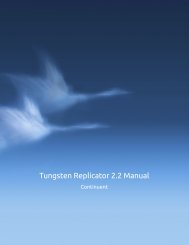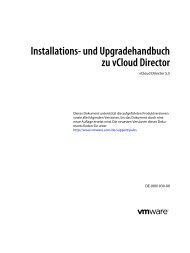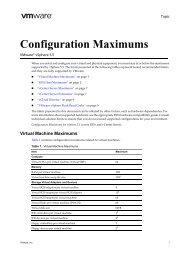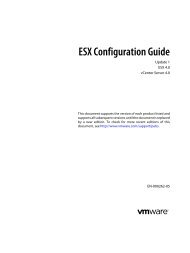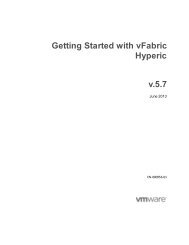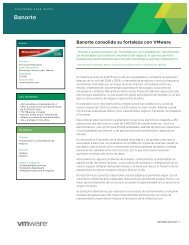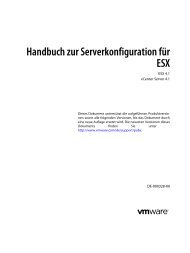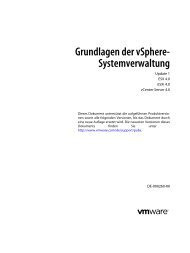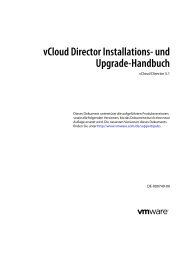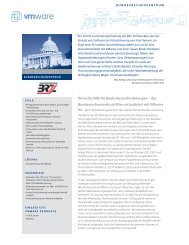vCenter Operations Manager for View Integration Guide 1.0 - VMware
vCenter Operations Manager for View Integration Guide 1.0 - VMware
vCenter Operations Manager for View Integration Guide 1.0 - VMware
Create successful ePaper yourself
Turn your PDF publications into a flip-book with our unique Google optimized e-Paper software.
<strong>VMware</strong> <strong>vCenter</strong> <strong>Operations</strong> <strong>Manager</strong><br />
<strong>for</strong> <strong>View</strong> <strong>Integration</strong> <strong>Guide</strong><br />
<strong>vCenter</strong> <strong>Operations</strong> <strong>Manager</strong> <strong>for</strong> <strong>View</strong> v<strong>1.0</strong><br />
This document supports the version of each product listed and<br />
supports all subsequent versions until the document is replaced<br />
by a new edition. To check <strong>for</strong> more recent editions of this<br />
document, see http://www.vmware.com/support/pubs.<br />
EN-000889-00
<strong>vCenter</strong> <strong>Operations</strong> <strong>Manager</strong> <strong>for</strong> <strong>View</strong> <strong>Integration</strong> <strong>Guide</strong><br />
You can find the most up-to-date technical documentation on the <strong>VMware</strong> Web site at:<br />
http://www.vmware.com/support/<br />
The <strong>VMware</strong> Web site also provides the latest product updates.<br />
If you have comments about this documentation, submit your feedback to:<br />
docfeedback@vmware.com<br />
Copyright © 2012 <strong>VMware</strong>, Inc. All rights reserved. This product is protected by U.S. and international copyright and<br />
intellectual property laws. <strong>VMware</strong> products are covered by one or more patents listed at<br />
http://www.vmware.com/go/patents.<br />
<strong>VMware</strong> is a registered trademark or trademark of <strong>VMware</strong>, Inc. in the United States and/or other jurisdictions. All other marks<br />
and names mentioned herein may be trademarks of their respective companies.<br />
<strong>VMware</strong>, Inc.<br />
3401 Hillview Ave.<br />
Palo Alto, CA 94304<br />
www.vmware.com<br />
2 <strong>VMware</strong>, Inc.
Contents<br />
About This Book 5<br />
1 Introducing <strong>vCenter</strong> <strong>Operations</strong> <strong>Manager</strong> <strong>for</strong> <strong>View</strong> 7<br />
Features of <strong>vCenter</strong> <strong>Operations</strong> <strong>Manager</strong> <strong>for</strong> <strong>View</strong> 7<br />
Customizing Dashboards and Widgets 7<br />
Health 7<br />
Architecture 8<br />
Steps to Set Up <strong>vCenter</strong> <strong>Operations</strong> <strong>Manager</strong> <strong>for</strong> <strong>View</strong> 9<br />
2 System Requirements 11<br />
Prerequisites be<strong>for</strong>e deploying <strong>vCenter</strong> <strong>Operations</strong> <strong>Manager</strong> <strong>for</strong> <strong>View</strong> 11<br />
Requirements <strong>for</strong> <strong>vCenter</strong> <strong>Operations</strong> <strong>Manager</strong> <strong>for</strong> <strong>View</strong> 12<br />
System Requirements <strong>for</strong> <strong>vCenter</strong> <strong>Operations</strong> <strong>Manager</strong> <strong>for</strong> <strong>View</strong> Adapter 12<br />
Support <strong>for</strong> up to 1000 desktop sessions 12<br />
Support <strong>for</strong> up to 2000 desktop sessions 12<br />
Download <strong>vCenter</strong> <strong>Operations</strong> <strong>Manager</strong> <strong>for</strong> <strong>View</strong> 12<br />
Support <strong>for</strong> Oracle databases that provide <strong>View</strong> Events 13<br />
3 Installing the <strong>vCenter</strong> <strong>Operations</strong> <strong>Manager</strong> <strong>for</strong> <strong>View</strong> Adapter 15<br />
Running the <strong>vCenter</strong> <strong>Operations</strong> <strong>Manager</strong> <strong>for</strong> <strong>View</strong> Windows Installer 15<br />
4 Configuring the <strong>vCenter</strong> <strong>Operations</strong> <strong>Manager</strong> <strong>for</strong> <strong>View</strong> Adapter 17<br />
Configuring the <strong>View</strong> Connection Server 17<br />
Configuring the <strong>vCenter</strong> <strong>Operations</strong> <strong>for</strong> <strong>View</strong> Adapter server 18<br />
Configuring <strong>View</strong> connection settings and credentials (<strong>View</strong> Settings tab) 18<br />
Default Port Settings <strong>for</strong> PowerShell 18<br />
Configuring <strong>vCenter</strong> <strong>Operations</strong> <strong>Manager</strong> Enterprise server settings and credentials (<strong>vCenter</strong><br />
<strong>Operations</strong> Settings tab) 20<br />
Configuring desktop VM settings and credentials (Desktop Settings) 21<br />
Windows XP Firewall Exceptions 21<br />
Windows Vista Firewall Exceptions 21<br />
Configuring Advanced settings (Advanced Settings tab) 23<br />
5 Deploying and Using <strong>vCenter</strong> <strong>Operations</strong> <strong>Manager</strong> <strong>for</strong> <strong>View</strong> Dashboards 27<br />
Installing the Dashboards 27<br />
Connect to the <strong>vCenter</strong> <strong>Operations</strong> <strong>Manager</strong> Admin Console 27<br />
Deploy the <strong>vCenter</strong> <strong>Operations</strong> <strong>Manager</strong> <strong>for</strong> <strong>View</strong> Adapter PAK file 28<br />
Using the <strong>vCenter</strong> <strong>Operations</strong> <strong>Manager</strong> Enterprise User Interface 30<br />
Validating your installation 30<br />
Adding <strong>vCenter</strong> <strong>Operations</strong> <strong>Manager</strong> Enterprise User Accounts 30<br />
Using the Dashboards 31<br />
Overview of dashboards and widgets 31<br />
<strong>View</strong> Main dashboard 31<br />
<strong>View</strong> Users dashboard 34<br />
<strong>View</strong> Top Desktop VMs 37<br />
<strong>View</strong> Pools dashboard 38<br />
<strong>View</strong> Desktop Sessions dashboard 40<br />
<strong>VMware</strong>, Inc. 3
<strong>vCenter</strong> <strong>Operations</strong> <strong>Manager</strong> <strong>for</strong> <strong>View</strong> <strong>Integration</strong> <strong>Guide</strong><br />
vSphere Infrastructure dashboard 42<br />
Appendix A, Important Metrics 45<br />
4 <strong>VMware</strong>, Inc.
About This Book<br />
The <strong>vCenter</strong> <strong>Operations</strong> <strong>Manager</strong> <strong>for</strong> <strong>View</strong> <strong>Integration</strong> <strong>Guide</strong> describes how to install, configure, and use<br />
<strong>VMware</strong> ® <strong>vCenter</strong> <strong>Operations</strong> <strong>Manager</strong> <strong>for</strong> <strong>View</strong> an automated intelligence system <strong>for</strong> IT operations.<br />
Intended Audience<br />
This guide is intended <strong>for</strong> anyone who must install and configure <strong>vCenter</strong> <strong>Operations</strong> <strong>Manager</strong> <strong>for</strong> <strong>View</strong> or<br />
use it to manage and monitor a VDI Infrastructure.<br />
<strong>VMware</strong> Technical Publications Glossary<br />
<strong>VMware</strong> Technical Publications provides a glossary of terms that might be unfamiliar to you. For definitions<br />
of terms as they are used in <strong>VMware</strong> technical documentation go to http://www.vmware.com/support/pubs.<br />
Document Feedback<br />
<strong>VMware</strong> welcomes your suggestions <strong>for</strong> improving our documentation. If you have comments, send your<br />
feedback to docfeedback@vmware.com.<br />
<strong>VMware</strong> <strong>vCenter</strong> <strong>Operations</strong> <strong>Manager</strong> <strong>for</strong> <strong>View</strong> Documentation<br />
The documentation set <strong>for</strong> <strong>VMware</strong> <strong>vCenter</strong> <strong>Operations</strong> <strong>Manager</strong> <strong>for</strong> <strong>View</strong> consists of the following<br />
documents.<br />
� <strong>VMware</strong> <strong>vCenter</strong> <strong>Operations</strong> <strong>Manager</strong> Deployment and Configuration <strong>Guide</strong>. Contains conceptual and<br />
procedural in<strong>for</strong>mation on using <strong>vCenter</strong> <strong>Operations</strong> <strong>Manager</strong> Enterprise.<br />
� <strong>vCenter</strong> <strong>Operations</strong> <strong>Manager</strong> Enterprise Getting Started <strong>Guide</strong>. Contains descriptions of VMWare <strong>vCenter</strong><br />
<strong>Operations</strong> <strong>Manager</strong> Enterprise, its user interface, and key terms and concepts. It also describes how to<br />
set up dashboards and configure widgets.<br />
� <strong>vCenter</strong> <strong>Operations</strong> <strong>Manager</strong> <strong>for</strong> <strong>View</strong> <strong>Integration</strong> <strong>Guide</strong>, this document.<br />
Technical Support and Education Resources<br />
The following sections describe the technical support resources available to you. To access the current version<br />
of this book and other books, go to http://www.vmware.com/support/pubs.<br />
Online and Telephone Support<br />
To use online support to submit technical support requests, view your product and contract in<strong>for</strong>mation, and<br />
register your products, go to http://www.vmware.com/support.<br />
Customers with appropriate support contracts should use telephone support <strong>for</strong> the fastest response on<br />
priority 1 issues. Go to http://www.vmware.com/support/phone_support.<br />
<strong>VMware</strong>, Inc. 5
<strong>vCenter</strong> <strong>Operations</strong> <strong>Manager</strong> <strong>for</strong> <strong>View</strong> <strong>Integration</strong> <strong>Guide</strong><br />
Support Offerings<br />
To find out how <strong>VMware</strong> support offerings can help meet your business needs, go to<br />
http://www.vmware.com/support/services.<br />
<strong>VMware</strong> Professional Services<br />
<strong>VMware</strong> Education Services courses offer extensive hands‐on labs, case study examples, and course materials<br />
designed to be used as on‐the‐job reference tools. Courses are available onsite, in the classroom, and live<br />
online. For onsite pilot programs and implementation best practices, <strong>VMware</strong> Consulting Services provides<br />
offerings to help you assess, plan, build, and manage your virtual environment. To access in<strong>for</strong>mation about<br />
education classes, certification programs, and consulting services, go to http://www.vmware.com/services.<br />
6 <strong>VMware</strong>, Inc.
1This<br />
Introducing <strong>vCenter</strong> <strong>Operations</strong><br />
1<br />
<strong>Manager</strong> <strong>for</strong> <strong>View</strong><br />
<strong>vCenter</strong> <strong>Operations</strong> <strong>Manager</strong> <strong>for</strong> <strong>View</strong> extends the functionality of <strong>vCenter</strong> <strong>Operations</strong> <strong>Manager</strong> Advanced<br />
and <strong>vCenter</strong> <strong>Operations</strong> <strong>Manager</strong> Enterprise to monitor and manage <strong>VMware</strong>® <strong>View</strong> environments. This is<br />
done through the <strong>vCenter</strong> <strong>Operations</strong> <strong>Manager</strong> <strong>for</strong> <strong>View</strong> Adapter which gets the topology from the <strong>VMware</strong><br />
<strong>View</strong> environment, collects metrics and other types of in<strong>for</strong>mation from managed desktops, and introduces<br />
this into <strong>vCenter</strong> <strong>Operations</strong> <strong>Manager</strong> Enterprise.<br />
Features of <strong>vCenter</strong> <strong>Operations</strong> <strong>Manager</strong> <strong>for</strong> <strong>View</strong><br />
<strong>vCenter</strong> <strong>Operations</strong> <strong>Manager</strong> <strong>for</strong> <strong>View</strong> extends the functionality of <strong>vCenter</strong> <strong>Operations</strong> <strong>Manager</strong> Enterprise,<br />
and enables IT administrators and Help Desk specialists to monitor and manage the <strong>View</strong> VDI environments.<br />
<strong>vCenter</strong> <strong>Operations</strong> <strong>Manager</strong> <strong>for</strong> <strong>View</strong> is built on top of the <strong>vCenter</strong> <strong>Operations</strong> <strong>Manager</strong> Enterprise.<br />
There<strong>for</strong>e, it includes the functionality of collecting per<strong>for</strong>mance data from monitored software and hardware<br />
resources in your enterprise and provides predictive analysis and real‐time in<strong>for</strong>mation about problems in<br />
your VDI infrastructure. It presents data and analysis through alerts, in configurable dashboards, and<br />
predefined pages in the user interface.<br />
The <strong>View</strong> Adapter gets the topology from the <strong>View</strong> environment, and gets metrics and other types of<br />
in<strong>for</strong>mation from the desktops, and passes the in<strong>for</strong>mation into <strong>vCenter</strong> <strong>Operations</strong> <strong>Manager</strong> Enterprise.<br />
The typical users of <strong>vCenter</strong> <strong>Operations</strong> <strong>Manager</strong> <strong>for</strong> <strong>View</strong> are IT Admininistrators and Help Desk specialists.<br />
The IT Administrator typically would use <strong>vCenter</strong> <strong>Operations</strong> <strong>Manager</strong> <strong>for</strong> <strong>View</strong> to get a quick overview of<br />
how the <strong>View</strong> environment is behaving, and to view some of the important metrics associated with their <strong>View</strong><br />
environment. A Helpdesk person may, in the process of assisting an end user with a VM or desktop issue, need<br />
to quickly see resources related to the end user’s session, and per<strong>for</strong>m basic troubleshooting to view, analyze,<br />
and resolve the issues that exist.<br />
Customizing Dashboards and Widgets<br />
<strong>VMware</strong> <strong>View</strong>‐specific dashboards and resources are automatically configured when you install <strong>vCenter</strong><br />
<strong>Operations</strong> <strong>Manager</strong> <strong>for</strong> <strong>View</strong>. These dashboards and resources added as part of the <strong>vCenter</strong> <strong>Operations</strong><br />
<strong>Manager</strong> <strong>for</strong> <strong>View</strong> installation and deployment are preconfigured dashboards, resources, metrics, and alerts.<br />
As with <strong>vCenter</strong> <strong>Operations</strong> <strong>Manager</strong> Enterprise, you can customize your <strong>vCenter</strong> <strong>Operations</strong> <strong>Manager</strong> <strong>for</strong><br />
<strong>View</strong> workspace. Depending on your access rights, you can add, delete, and arrange widgets on your<br />
dashboards, edit widget configuration options, and configure widget interactions.<br />
Widgets include configuration options that you can edit to customize them <strong>for</strong> your particular needs. The<br />
available configuration options vary depending on the widget type. For details on how to customize and<br />
configure dashboards and widgets in <strong>vCenter</strong> <strong>Operations</strong> <strong>Manager</strong> <strong>for</strong> <strong>View</strong>, see the <strong>vCenter</strong> <strong>Operations</strong><br />
<strong>Manager</strong> Enterprise Getting Started <strong>Guide</strong>.<br />
<strong>VMware</strong>, Inc. 7
<strong>vCenter</strong> <strong>Operations</strong> <strong>Manager</strong> <strong>for</strong> <strong>View</strong> <strong>Integration</strong> <strong>Guide</strong><br />
Health<br />
<strong>vCenter</strong> <strong>Operations</strong> <strong>Manager</strong> <strong>for</strong> <strong>View</strong> incorporates the health ratings feature of <strong>vCenter</strong> <strong>Operations</strong> <strong>Manager</strong><br />
Enterprise which gives you a quick overview of the current state of a resource in your VDI environment.<br />
<strong>vCenter</strong> <strong>Operations</strong> <strong>Manager</strong> Enterprise uses an internally‐generated metric instead of the Health badge used<br />
by <strong>vCenter</strong> <strong>Operations</strong> <strong>Manager</strong> Advanced. The <strong>vCenter</strong> <strong>Operations</strong> <strong>Manager</strong> Enterprise health score is<br />
calculated using resource metric anomalies and is best described as an indicator of how closely the resource is<br />
behaving to its “normal” observed behavior. If many resource metrics are outside their expected range, then<br />
this is reflected in a decreased Health score.<br />
For more details on understanding health ratings, see the <strong>vCenter</strong> <strong>Operations</strong> <strong>Manager</strong> Enterprise Getting Started<br />
<strong>Guide</strong>.<br />
Architecture<br />
<strong>vCenter</strong> <strong>Operations</strong> <strong>Manager</strong> <strong>for</strong> <strong>View</strong> is a solution built on top of the <strong>vCenter</strong> <strong>Operations</strong> <strong>Manager</strong> Enterprise<br />
plat<strong>for</strong>m which enables you to monitor your <strong>VMware</strong> <strong>View</strong> 5.0 VDI environment.<br />
The diagram below shows the relationship of <strong>vCenter</strong> <strong>Operations</strong> <strong>Manager</strong> Enterprise, the <strong>vCenter</strong> <strong>Operations</strong><br />
<strong>Manager</strong> <strong>for</strong> <strong>View</strong> Adapter, and their relationships to other <strong>vCenter</strong> <strong>Operations</strong> <strong>Manager</strong> <strong>for</strong> <strong>View</strong> VDI<br />
components.<br />
Figure 1-1. <strong>vCenter</strong> <strong>Operations</strong> <strong>Manager</strong> <strong>for</strong> <strong>View</strong> Architecture<br />
8 <strong>VMware</strong>, Inc.
Chapter 1 Introducing <strong>vCenter</strong> <strong>Operations</strong> <strong>Manager</strong> <strong>for</strong> <strong>View</strong><br />
To use <strong>vCenter</strong> <strong>Operations</strong> <strong>Manager</strong> <strong>for</strong> <strong>View</strong>, there are two main components that you need to install:<br />
� <strong>vCenter</strong> <strong>Operations</strong> <strong>Manager</strong> Enterprise vApp v5.0.1 or higher<br />
For details on installing the <strong>vCenter</strong> <strong>Operations</strong> <strong>Manager</strong> Enterprise, see:<br />
https://www.vmware.com/pdf/vcops‐5‐installation‐guide.pdf<br />
� <strong>vCenter</strong> <strong>Operations</strong> <strong>Manager</strong> <strong>for</strong> <strong>View</strong> Adapter v<strong>1.0</strong><br />
For in<strong>for</strong>mation on installing the <strong>vCenter</strong> <strong>Operations</strong> <strong>Manager</strong> <strong>for</strong> <strong>View</strong> Adapter, see “Installing the<br />
<strong>vCenter</strong> <strong>Operations</strong> <strong>Manager</strong> <strong>for</strong> <strong>View</strong> Adapter” on page 15.<br />
You install the <strong>vCenter</strong> <strong>Operations</strong> <strong>Manager</strong> <strong>for</strong> <strong>View</strong> Adapter using an installation file on a separate Windows<br />
server VM. Installing and configuring these two components is described in the following chapters.<br />
Steps to Set Up <strong>vCenter</strong> <strong>Operations</strong> <strong>Manager</strong> <strong>for</strong> <strong>View</strong><br />
The setup process <strong>for</strong> <strong>VMware</strong> <strong>vCenter</strong> <strong>Operations</strong> <strong>Manager</strong> <strong>for</strong> <strong>View</strong> is comprised of the following steps:<br />
1 Verify hardware/software requirements—see “System Requirements” on page 11<br />
2 Install and configure the <strong>vCenter</strong> <strong>Operations</strong> <strong>Manager</strong> Enterprise vApp. For in<strong>for</strong>mation on how to do<br />
this, refer to the <strong>vCenter</strong> <strong>Operations</strong> <strong>Manager</strong> Enterprise documentation at the following URL:<br />
https://www.vmware.com/support/pubs/vcops‐pubs.html<br />
3 Install the <strong>vCenter</strong> <strong>Operations</strong> <strong>Manager</strong> <strong>for</strong> <strong>View</strong> adapter—“Installing the <strong>vCenter</strong> <strong>Operations</strong> <strong>Manager</strong><br />
<strong>for</strong> <strong>View</strong> Adapter” on page 15.<br />
4 Run the EnableRemotePS.cmd script on the <strong>View</strong> Connection Server. See “Configuring the <strong>View</strong><br />
Connection Server” on page 17.<br />
5 Configure the <strong>vCenter</strong> <strong>Operations</strong> <strong>Manager</strong> <strong>for</strong> <strong>View</strong> adapter on the <strong>View</strong> Adapter Windows server VM<br />
See “Configuring the <strong>vCenter</strong> <strong>Operations</strong> <strong>Manager</strong> <strong>for</strong> <strong>View</strong> Adapter” on page 17.<br />
6 Deploy dashboards—“Deploying and Using <strong>vCenter</strong> <strong>Operations</strong> <strong>Manager</strong> <strong>for</strong> <strong>View</strong> Dashboards” on<br />
page 27.<br />
<strong>VMware</strong>, Inc. 9
<strong>vCenter</strong> <strong>Operations</strong> <strong>Manager</strong> <strong>for</strong> <strong>View</strong> <strong>Integration</strong> <strong>Guide</strong><br />
10 <strong>VMware</strong>, Inc.
2<br />
System Requirements 2<br />
The following sections describe the prerequisites, system requirements, and compatibilities <strong>for</strong> <strong>vCenter</strong><br />
<strong>Operations</strong> <strong>Manager</strong> <strong>for</strong> <strong>View</strong>.<br />
This chapter includes the following topics:<br />
� “Prerequisites be<strong>for</strong>e deploying <strong>vCenter</strong> <strong>Operations</strong> <strong>Manager</strong> <strong>for</strong> <strong>View</strong>” on page 11<br />
� “Requirements <strong>for</strong> <strong>vCenter</strong> <strong>Operations</strong> <strong>Manager</strong> <strong>for</strong> <strong>View</strong>” on page 12<br />
� “Download <strong>vCenter</strong> <strong>Operations</strong> <strong>Manager</strong> <strong>for</strong> <strong>View</strong>” on page 12<br />
Prerequisites be<strong>for</strong>e deploying <strong>vCenter</strong> <strong>Operations</strong> <strong>Manager</strong> <strong>for</strong> <strong>View</strong><br />
This is a list of prerequisites that must be per<strong>for</strong>med be<strong>for</strong>e installing and deploying <strong>vCenter</strong> <strong>Operations</strong><br />
<strong>Manager</strong> <strong>for</strong> <strong>View</strong>.<br />
� Obtain, download, install, and configure the <strong>vCenter</strong> <strong>Operations</strong> <strong>Manager</strong> Enterprise vApp.<br />
� <strong>vCenter</strong> <strong>Operations</strong> <strong>Manager</strong> <strong>for</strong> <strong>View</strong> v<strong>1.0</strong> requires the <strong>vCenter</strong> <strong>Operations</strong> <strong>Manager</strong> Enterprise vApp,<br />
not the standalone version.<br />
NOTE Instructions in this guide assume that <strong>vCenter</strong> <strong>Operations</strong> <strong>Manager</strong> Enterprise vApp has already been<br />
installed and deployed.<br />
Refer to the <strong>vCenter</strong> <strong>Operations</strong> <strong>Manager</strong> Enterprise vApp documentation here:<br />
https://www.vmware.com/support/pubs/vcops‐pubs.html<br />
NOTE <strong>vCenter</strong> <strong>Operations</strong> <strong>Manager</strong> <strong>for</strong> <strong>View</strong> requires <strong>vCenter</strong> <strong>Operations</strong> <strong>Manager</strong> Enterprise vApp, version<br />
5.0.1 or higher.<br />
� You must install <strong>vCenter</strong> <strong>Operations</strong> <strong>Manager</strong> <strong>for</strong> <strong>View</strong> v<strong>1.0</strong> into a <strong>View</strong> 5.0 or later VDI environment.<br />
Refer to the <strong>View</strong> documentation here:<br />
https://www.vmware.com/support/pubs/view‐pubs.html<br />
� The Windows Server 2008 R2 64‐bit operating system is the recommended server plat<strong>for</strong>m <strong>for</strong> the <strong>vCenter</strong><br />
<strong>Operations</strong> <strong>Manager</strong> <strong>for</strong> <strong>View</strong> <strong>1.0</strong> Adapter installation.<br />
� Both SQL Server and Oracle database servers are supported <strong>for</strong> the <strong>View</strong> Events DB, but if you use Oracle<br />
database servers, you may need to update the client software.<br />
You may need to update the Oracle client libraries (ODAC) on the <strong>vCenter</strong> <strong>Operations</strong> <strong>for</strong> <strong>View</strong> Adapter<br />
server if <strong>View</strong> is configured with an Oracle Events database. For details, see “Support <strong>for</strong> Oracle databases<br />
that provide <strong>View</strong> Events” on page 13.<br />
� Be<strong>for</strong>e you install the <strong>vCenter</strong> <strong>Operations</strong> <strong>Manager</strong> <strong>for</strong> <strong>View</strong> Adapter, you must install the Microsoft .NET<br />
Framework version 3.5.<br />
NOTE Microsoft .NET version 3.5 ships with both Windows 2003 and Windows 2008 as an optional Windows<br />
component or feature, which you can enable from the Control Panel or Server <strong>Manager</strong> utilities.<br />
<strong>VMware</strong>, Inc. 11
<strong>vCenter</strong> <strong>Operations</strong> <strong>Manager</strong> <strong>for</strong> <strong>View</strong> <strong>Integration</strong> <strong>Guide</strong><br />
Requirements <strong>for</strong> <strong>vCenter</strong> <strong>Operations</strong> <strong>Manager</strong> <strong>for</strong> <strong>View</strong><br />
The following lists system requirements <strong>for</strong> <strong>vCenter</strong> <strong>Operations</strong> <strong>Manager</strong> <strong>for</strong> <strong>View</strong>.<br />
NOTE <strong>vCenter</strong> <strong>Operations</strong> <strong>Manager</strong> <strong>for</strong> <strong>View</strong> supports up to 2000 concurrent desktop sessions (connected or<br />
disconnected).<br />
These requirements or recommendations include only logged‐on user sessions. Typically, only a portion of all<br />
VDI desktops are logged on at any given time.<br />
System Requirements <strong>for</strong> <strong>vCenter</strong> <strong>Operations</strong> <strong>Manager</strong> <strong>for</strong> <strong>View</strong> Adapter<br />
Support <strong>for</strong> up to 1000 desktop sessions<br />
� OS: Windows 2003 R2, Windows 2008 R2, 64‐bit OS<br />
� Processors: 2 cores, 2.8 Ghz or above<br />
� Memory: 6 GB<br />
� Disk Space: 30 GB<br />
Support <strong>for</strong> up to 2000 desktop sessions<br />
� OS: Windows 2003 R2, Windows 2008 R2, 64‐bit OS<br />
� Processors: 4 cores, 2.8 Ghz or above<br />
� Memory: 8 GB<br />
� Disk space: 30 GB<br />
NOTE The <strong>vCenter</strong> <strong>Operations</strong> <strong>Manager</strong> <strong>for</strong> <strong>View</strong> Adapter requires a 64‐bit Windows (Windows 2003 or 2008)<br />
VM. VMs that are 32‐bit based are not supported in this release.<br />
If the hardware and software environment has been set up properly, the complete <strong>vCenter</strong> <strong>Operations</strong><br />
<strong>Manager</strong> <strong>for</strong> <strong>View</strong> installation and deployment process should take about 1 hour (excluding download times).<br />
Download <strong>vCenter</strong> <strong>Operations</strong> <strong>Manager</strong> <strong>for</strong> <strong>View</strong><br />
This guide assumes that you have already purchased <strong>vCenter</strong> <strong>Operations</strong> <strong>Manager</strong> <strong>for</strong> <strong>View</strong>. If you have not<br />
purchased it yet, you can do so at the following URL:<br />
https://www.vmware.com/vmwarestore/datacenter‐products/buyoperations.html<br />
For permanent licensing keys go to the following URL:<br />
https://www.vmware.com/licensing/license.portal<br />
When downloading <strong>vCenter</strong> <strong>Operations</strong> <strong>Manager</strong> <strong>for</strong> <strong>View</strong> at the previous URL, You will see the following<br />
download:<br />
� <strong>View</strong> Adapter 64‐bit (encrypted zip)<br />
64‐bit: <strong>VMware</strong>-vcops-viewadapter-x86_64-<strong>1.0</strong>.0-XXXXXX.exe<br />
You will now have a Windows installation package containing an .exe file that you can install.<br />
The default installation folder is<br />
c:\Program Files\<strong>VMware</strong>\<strong>vCenter</strong> <strong>Operations</strong>\<strong>View</strong> Adapter<br />
� Oracle client libraries (ODAC) may need to be updated on the <strong>View</strong> Adapter server if <strong>View</strong> is configured<br />
with an Oracle Events database.<br />
12 <strong>VMware</strong>, Inc.
Support <strong>for</strong> Oracle databases that provide <strong>View</strong> Events<br />
NOTE This may be required if you have a <strong>View</strong> installation using an Oracle Events DB.<br />
Chapter 2 System Requirements<br />
When adding support <strong>for</strong> Oracle <strong>View</strong> Events databases, the client libraries may need to be updated on the<br />
<strong>vCenter</strong> <strong>Operations</strong> <strong>for</strong> <strong>View</strong> adapter server, depending on the version of the Oracle DB server in use.<br />
You can download this update from the following link:<br />
NOTE This update is <strong>for</strong> 64‐bit systems only.<br />
http://www.oracle.com/technetwork/database/windows/downloads/index-090165.html<br />
From this page, download the zip file from the 64‐bit ODAC 11.2 Release 4 (11.2.0.3.0) Xcopy <strong>for</strong> Windows<br />
x64 link and follow the instructions in the readme.html file included in the zip file.<br />
<strong>VMware</strong>, Inc. 13
<strong>vCenter</strong> <strong>Operations</strong> <strong>Manager</strong> <strong>for</strong> <strong>View</strong> <strong>Integration</strong> <strong>Guide</strong><br />
14 <strong>VMware</strong>, Inc.
3<br />
Installing the <strong>vCenter</strong> <strong>Operations</strong><br />
3<br />
<strong>Manager</strong> <strong>for</strong> <strong>View</strong> Adapter<br />
Installing <strong>vCenter</strong> <strong>Operations</strong> <strong>Manager</strong> <strong>for</strong> <strong>View</strong> consists of running an executable file, which starts an<br />
installation wizard.<br />
Prerequisites<br />
� Obtain and download <strong>vCenter</strong> <strong>Operations</strong> <strong>Manager</strong> <strong>for</strong> <strong>View</strong> from the following URL:<br />
https://www.vmware.com/vmwarestore/datacenter‐products/buyoperations.html<br />
NOTE The <strong>vCenter</strong> <strong>Operations</strong> <strong>Manager</strong> <strong>for</strong> <strong>View</strong> Adapter does not require license keys. However, license<br />
keys are required when installing the <strong>vCenter</strong> <strong>Operations</strong> <strong>Manager</strong> Enterprise vApp.<br />
On the VMWare download site, you will see the following:<br />
� <strong>View</strong> Adapter 64‐bit (encrypted zip)<br />
(64‐bit) <strong>VMware</strong>-vcops-viewadapter-x86_64-<strong>1.0</strong>.0.exe<br />
NOTE The <strong>vCenter</strong> <strong>Operations</strong> <strong>for</strong> <strong>View</strong> Adapter <strong>for</strong> 32‐bit systems is not supported.<br />
Running the <strong>vCenter</strong> <strong>Operations</strong> <strong>Manager</strong> <strong>for</strong> <strong>View</strong> Windows Installer<br />
After you have downloaded the installation package, you are ready to install the <strong>vCenter</strong> <strong>Operations</strong> <strong>Manager</strong><br />
<strong>for</strong> <strong>View</strong> Adapter.<br />
After downloading the installation package, you will have an installer .exe file.<br />
Agree to the presented EULAs and follow the instructions presented by the installation wizard.<br />
After you install <strong>vCenter</strong> <strong>Operations</strong> <strong>Manager</strong> <strong>for</strong> <strong>View</strong>, the configuration utility will be launched by default.<br />
Proceed to “Configuring the <strong>vCenter</strong> <strong>Operations</strong> <strong>Manager</strong> <strong>for</strong> <strong>View</strong> Adapter” on page 17.<br />
<strong>VMware</strong>, Inc. 15
<strong>vCenter</strong> <strong>Operations</strong> <strong>Manager</strong> <strong>for</strong> <strong>View</strong> <strong>Integration</strong> <strong>Guide</strong><br />
16 <strong>VMware</strong>, Inc.
4<br />
Configuring the <strong>vCenter</strong> <strong>Operations</strong><br />
4<br />
<strong>Manager</strong> <strong>for</strong> <strong>View</strong> Adapter<br />
After installing <strong>vCenter</strong> <strong>Operations</strong> <strong>Manager</strong> <strong>for</strong> <strong>View</strong> you are ready to configure the <strong>vCenter</strong> <strong>Operations</strong> <strong>for</strong><br />
<strong>View</strong> Adapter using the utility provided.<br />
Prerequisites<br />
NOTE Confirm that the <strong>vCenter</strong> <strong>Operations</strong> <strong>Manager</strong> Enterprise is installed and running be<strong>for</strong>e you start the<br />
<strong>vCenter</strong> <strong>Operations</strong> <strong>Manager</strong> <strong>for</strong> <strong>View</strong> adapter.<br />
The <strong>vCenter</strong> <strong>Operations</strong> <strong>Manager</strong> <strong>for</strong> <strong>View</strong> adapter needs access to a number of resources to collect<br />
in<strong>for</strong>mation about the <strong>VMware</strong> <strong>View</strong> topology and metrics. Connection in<strong>for</strong>mation and credentials are<br />
required <strong>for</strong> each resource, which you configure from the <strong>vCenter</strong> <strong>Operations</strong> <strong>View</strong> Adapter Settings utility.<br />
By default, the <strong>vCenter</strong> <strong>Operations</strong> <strong>View</strong> Adapter Settings utility is launched after installation completes.<br />
Additionally, you must configure the <strong>View</strong> Connection Server to allow remote PowerShell connections be<strong>for</strong>e<br />
the <strong>View</strong> Adapter service can be started. A script is included with the <strong>vCenter</strong> <strong>Operations</strong> <strong>Manager</strong> <strong>for</strong> <strong>View</strong><br />
Installation package that you can use <strong>for</strong> this task, which is described in “Configuring the <strong>View</strong> Connection<br />
Server” on page 17.<br />
Configuring the <strong>View</strong> Connection Server<br />
Be<strong>for</strong>e starting the <strong>vCenter</strong> <strong>Operations</strong> <strong>Manager</strong> <strong>for</strong> <strong>View</strong> Adapter service, you must configure the <strong>View</strong><br />
Connection Server. Configuration is necessary to enable remote PowerShell sessions and initialize <strong>View</strong><br />
PowerShell extensions on the <strong>View</strong> Connection Server.<br />
1 Copy the PowerShell command Enable<strong>View</strong>PS.cmd from the <strong>vCenter</strong> <strong>Operations</strong> <strong>Manager</strong> <strong>for</strong> <strong>View</strong><br />
Adapter installation folder onto the <strong>VMware</strong> <strong>View</strong> Connection Server.<br />
The default installation folder <strong>for</strong> <strong>vCenter</strong> <strong>Operations</strong> <strong>Manager</strong> <strong>for</strong> <strong>View</strong> is:<br />
c:\Program Files\<strong>VMware</strong>\<strong>vCenter</strong> <strong>Operations</strong>\<strong>View</strong> Adapter<br />
2 On the <strong>View</strong> Connection Server, as administrator, run the following command:<br />
Enable<strong>View</strong>PS.cmd<br />
The Enable<strong>View</strong>PS.cmd script does the following:<br />
� Initializes the <strong>VMware</strong> <strong>View</strong> PowerCLI cmdlets.<br />
� Enable remote PowerShell sessions.<br />
� Open firewall ports needed <strong>for</strong> remote PowerShell sessions.<br />
NOTE In environments that have more than one <strong>View</strong> Connection Server, you only need to run the script on<br />
the one <strong>View</strong> Connection Server that you are configuring the <strong>vCenter</strong> <strong>Operations</strong> <strong>Manager</strong> <strong>for</strong> <strong>View</strong> Adapter<br />
<strong>for</strong>. You do not need to run the script on the other connection servers.<br />
<strong>VMware</strong>, Inc. 17
<strong>vCenter</strong> <strong>Operations</strong> <strong>Manager</strong> <strong>for</strong> <strong>View</strong> <strong>Integration</strong> <strong>Guide</strong><br />
Configuring the <strong>vCenter</strong> <strong>Operations</strong> <strong>for</strong> <strong>View</strong> Adapter server<br />
To configure the <strong>vCenter</strong> <strong>Operations</strong> <strong>for</strong> <strong>View</strong> adapter, you use the <strong>vCenter</strong> <strong>Operations</strong> <strong>for</strong> <strong>View</strong> Adapter<br />
Settings utility. By default, this utility is launched after the <strong>vCenter</strong> <strong>Operations</strong> <strong>for</strong> <strong>View</strong> Adapter installation<br />
completes. You can also start it from the Start Menu by using:<br />
Start Menu-><strong>VMware</strong>-><strong>vCenter</strong> <strong>Operations</strong> <strong>for</strong> <strong>View</strong>-><strong>View</strong> Adapter Settings<br />
When you initially run the <strong>View</strong> Adapter Settings utility, review each tab to fill in all appropriate credentials<br />
and connection settings. After installation, you can run the utility at any time from the Start menu to update<br />
the configuration.<br />
Each group of settings has a Test button that you can use to verify connection settings and credentials. After<br />
all settings are configured, click Apply to save the settings and start the <strong>vCenter</strong> <strong>Operations</strong> <strong>Manager</strong> <strong>for</strong> <strong>View</strong><br />
Adapter service.<br />
IMPORTANT It is recommended that you click Test after configuring each group of settings on each<br />
configuration tab. This runs a test that the configuration is set up correctly so far.<br />
Configuring <strong>View</strong> connection settings and credentials (<strong>View</strong> Settings tab)<br />
You can configure <strong>View</strong> server connection settings and credentials on the <strong>View</strong> Settings tab.<br />
The username and password that you enter must have read access to the <strong>View</strong> Connection Server. (Typically,<br />
this account is included in the Local Admins group on the server).<br />
Default Port Settings <strong>for</strong> PowerShell<br />
The default ports <strong>for</strong> remote PowerShell are<br />
� 5985 (HTTP)<br />
� 5986 (HTTPS)<br />
Optionally, you can specify one or more <strong>View</strong> desktop pools that you want to monitor. If no pools are<br />
specified, then all pools will be monitored.<br />
Credentials <strong>for</strong> the <strong>View</strong> events database are optional but highly recommended. Additional <strong>View</strong> specific<br />
events, metrics, and alerts are collected when you provide access to the database (including desktop login and<br />
reconnection times). For details on how to set up the Events database, see “Support <strong>for</strong> Oracle databases that<br />
provide <strong>View</strong> Events” on page 13 and the <strong>vCenter</strong> <strong>Operations</strong> <strong>Manager</strong> Enterprise Administrator <strong>Guide</strong>.<br />
18 <strong>VMware</strong>, Inc.
Figure 4-1. <strong>VMware</strong> <strong>View</strong> Settings tab<br />
Chapter 4 Configuring the <strong>vCenter</strong> <strong>Operations</strong> <strong>Manager</strong> <strong>for</strong> <strong>View</strong> Adapter<br />
<strong>VMware</strong>, Inc. 19
<strong>vCenter</strong> <strong>Operations</strong> <strong>Manager</strong> <strong>for</strong> <strong>View</strong> <strong>Integration</strong> <strong>Guide</strong><br />
Configuring <strong>vCenter</strong> <strong>Operations</strong> <strong>Manager</strong> Enterprise server settings and<br />
credentials (<strong>vCenter</strong> <strong>Operations</strong> Settings tab)<br />
Next, configure the <strong>vCenter</strong> <strong>Operations</strong> <strong>Manager</strong> Enterprise server settings and credentials on the <strong>vCenter</strong><br />
<strong>Operations</strong> Settings tab. When using the <strong>vCenter</strong> <strong>Operations</strong> <strong>Manager</strong> Enterprise vApp, enter the name or<br />
IP address <strong>for</strong> the <strong>vCenter</strong> <strong>Operations</strong> <strong>Manager</strong> Enterprise UI VM, not the name or IP address <strong>for</strong> the Analytics<br />
VM. See Figure 4‐2.<br />
NOTE This in<strong>for</strong>mation is specific to the <strong>vCenter</strong> <strong>Operations</strong> <strong>Manager</strong> Enterprise vApp, not the standalone<br />
version.<br />
By default, the <strong>vCenter</strong> <strong>Operations</strong> <strong>Manager</strong> <strong>for</strong> <strong>View</strong> vApp installation uses HTTPS and enables HTTP Post<br />
Adapter authentication. HTTP Post Adapter authentication requires that you provide additional credentials.<br />
NOTE The username and password specify a <strong>vCenter</strong> <strong>Operations</strong> <strong>Manager</strong> Enterprise user account rather<br />
than a domain account.<br />
Figure 4-2. <strong>vCenter</strong> <strong>Operations</strong> <strong>Manager</strong> Enterprise Settings tab<br />
20 <strong>VMware</strong>, Inc.
Chapter 4 Configuring the <strong>vCenter</strong> <strong>Operations</strong> <strong>Manager</strong> <strong>for</strong> <strong>View</strong> Adapter<br />
Configuring desktop VM settings and credentials (Desktop Settings)<br />
You configure desktop VM settings and credentials on the Desktop Settings tab. It is highly recommended that<br />
you specify a desktop username and password. Without proper credentials, metric data will not be collected<br />
from desktop VMs and the connected <strong>VMware</strong> <strong>View</strong> clients will not be created. The credentials that you<br />
provide must specify a domain account, which is included in the Local Admins group on each desktop VM<br />
being monitored.<br />
Figure 4-3. <strong>vCenter</strong> <strong>Operations</strong> <strong>Manager</strong> <strong>for</strong> <strong>View</strong> Desktop Settings tab<br />
Each desktop VM must have the Remote Registry service and the Windows Management Instrumentation<br />
(WMI) service enabled and running <strong>for</strong> metric data to be collected <strong>for</strong> that VM.<br />
You must also configure the firewall settings on each desktop to allow inbound Remote Registry and WMI<br />
service requests. You can do this by either disabling the firewall or applying the following firewall exceptions<br />
or allowed programs, using the following in<strong>for</strong>mation.<br />
Windows XP Firewall Exceptions<br />
� Remote Registry<br />
� File and Printer Sharing<br />
� WMI<br />
� Go to: http://support.microsoft.com/kb/875605<br />
Windows Vista Firewall Exceptions<br />
� Remote Registry<br />
� File and Printer Sharing<br />
� WMI<br />
� Windows Management Instrumentation (WMI)<br />
<strong>VMware</strong>, Inc. 21
<strong>vCenter</strong> <strong>Operations</strong> <strong>Manager</strong> <strong>for</strong> <strong>View</strong> <strong>Integration</strong> <strong>Guide</strong><br />
Windows 7 Allowed Programs<br />
� Remote Registry<br />
� File and Printer Sharing<br />
� WMI<br />
� Windows Management Instrumentation (WMI)<br />
Ideally, you should configure these settings in the desktop template or base image. You may also enable them<br />
through a Group Policy Object (GPO) or manually configure them <strong>for</strong> each desktop.<br />
22 <strong>VMware</strong>, Inc.
Configuring Advanced settings (Advanced Settings tab)<br />
You can configure other settings on the Advanced tab.<br />
Chapter 4 Configuring the <strong>vCenter</strong> <strong>Operations</strong> <strong>Manager</strong> <strong>for</strong> <strong>View</strong> Adapter<br />
Log level defaults to 3–info. After an installation has been up and reliably running <strong>for</strong> several days, you can<br />
decrease this setting. You may need to increase it to 4‐verbose <strong>for</strong> short periods <strong>for</strong> debugging purposes. This<br />
log level directly affects the size of the log files. Note that log files older than 7 days will be automatically<br />
deleted.<br />
The collection interval specifies the time between <strong>View</strong> topography updates. In large VDI environments,<br />
topography updates can take a long time and add load to the <strong>View</strong> Connection Server, so less frequent updates<br />
may be desirable. Recommendations by number of desktop VMs are as follows:<br />
� up to 2000 desktops—5 minutes<br />
NOTE A collection interval of 5 minutes should work <strong>for</strong> up to 2000 desktops, based on recent testing results.<br />
The configuration utility has not yet been updated to reflect this new recommendation.<br />
It is recommended that you leave the collection threads at the default of 20.<br />
If a customer‐provided certificate is used, it may be desirable to increase the certificate policy to High. The<br />
default Medium setting works best if you are not using a custom certificate.<br />
NOTE You can also start and stop the <strong>View</strong> Adapter service on this tab.<br />
However, make sure that you save your configuration settings by clicking Apply be<strong>for</strong>e leaving this tab.<br />
IMPORTANT Be<strong>for</strong>e you start the <strong>vCenter</strong> <strong>Operations</strong> <strong>Manager</strong> <strong>for</strong> <strong>View</strong> adapter, make sure that the <strong>vCenter</strong><br />
<strong>Operations</strong> <strong>Manager</strong> Enterprise vApp is installed and running.<br />
<strong>VMware</strong>, Inc. 23
<strong>vCenter</strong> <strong>Operations</strong> <strong>Manager</strong> <strong>for</strong> <strong>View</strong> <strong>Integration</strong> <strong>Guide</strong><br />
Figure 4-4. <strong>vCenter</strong> <strong>Operations</strong> <strong>Manager</strong> <strong>for</strong> <strong>View</strong> Advanced Settings<br />
It is recommended that you run connection tests after you apply each category of settings.<br />
The following status dialog displays when all settings and credentials have been configured properly.<br />
24 <strong>VMware</strong>, Inc.
Chapter 4 Configuring the <strong>vCenter</strong> <strong>Operations</strong> <strong>Manager</strong> <strong>for</strong> <strong>View</strong> Adapter<br />
<strong>VMware</strong>, Inc. 25
<strong>vCenter</strong> <strong>Operations</strong> <strong>Manager</strong> <strong>for</strong> <strong>View</strong> <strong>Integration</strong> <strong>Guide</strong><br />
26 <strong>VMware</strong>, Inc.
5<br />
Deploying and Using <strong>vCenter</strong><br />
<strong>Operations</strong> <strong>Manager</strong> <strong>for</strong> <strong>View</strong><br />
Dashboards 5<br />
For monitoring and troubleshooting your <strong>View</strong> VDI environment, seven dashboards are created<br />
out‐of‐the‐box. Installation of <strong>vCenter</strong> <strong>Operations</strong> <strong>Manager</strong> <strong>for</strong> <strong>View</strong> dashboards is automated by deploying<br />
a PAK file using the <strong>vCenter</strong> <strong>Operations</strong> <strong>Manager</strong> Enterprise update mechanism as described in “Installing the<br />
Dashboards” on page 27. The PAK file is included with the <strong>vCenter</strong> <strong>Operations</strong> <strong>for</strong> <strong>View</strong> adapter installation.<br />
Installing the Dashboards<br />
The process of installing dashboards is comprised of the following steps:<br />
1 Connect to the <strong>vCenter</strong> <strong>Operations</strong> <strong>Manager</strong> Admin Console.<br />
2 Deploy the <strong>vCenter</strong> <strong>Operations</strong> <strong>Manager</strong> <strong>for</strong> <strong>View</strong> Adapter PAK file:<br />
<strong>VMware</strong>-vcops-viewadapter.pak<br />
The PAK file is located in the default <strong>vCenter</strong> <strong>Operations</strong> <strong>Manager</strong> <strong>for</strong> <strong>View</strong> Installation folder:<br />
c:\Program Files\<strong>VMware</strong>\<strong>vCenter</strong> <strong>Operations</strong>\<strong>View</strong><br />
Adapter\<strong>VMware</strong>-vcops-viewadapter.pak<br />
Connect to the <strong>vCenter</strong> <strong>Operations</strong> <strong>Manager</strong> Admin Console<br />
To connect to the <strong>vCenter</strong> <strong>Operations</strong> <strong>Manager</strong> Admin Console:<br />
1 Open the <strong>vCenter</strong> <strong>Operations</strong> <strong>Manager</strong> Admin Console using the following URL:<br />
https:///admin<br />
See the <strong>vCenter</strong> <strong>Operations</strong> <strong>Manager</strong> Admin Console in “<strong>vCenter</strong> <strong>Operations</strong> <strong>Manager</strong> Admin<br />
Console—Update package screen” on page 28.<br />
<strong>VMware</strong>, Inc. 27
<strong>vCenter</strong> <strong>Operations</strong> <strong>Manager</strong> <strong>for</strong> <strong>View</strong> <strong>Integration</strong> <strong>Guide</strong><br />
Figure 5-1. <strong>vCenter</strong> <strong>Operations</strong> <strong>Manager</strong> Administration Console<br />
2 Log onto the <strong>vCenter</strong> <strong>Operations</strong> <strong>Manager</strong> Admin Console using the admin account.<br />
Deploy the <strong>vCenter</strong> <strong>Operations</strong> <strong>Manager</strong> <strong>for</strong> <strong>View</strong> Adapter PAK file<br />
1 In the <strong>vCenter</strong> <strong>Operations</strong> <strong>Manager</strong> Admin Console, open the Update page shown in “<strong>vCenter</strong><br />
<strong>Operations</strong> <strong>Manager</strong> Admin Console—Update package screen” on page 28.<br />
Figure 5-2. <strong>vCenter</strong> <strong>Operations</strong> <strong>Manager</strong> Admin Console—Update package screen<br />
2 Click the Browse button. Navigate to the <strong>vCenter</strong> <strong>Operations</strong> <strong>Manager</strong> <strong>for</strong> <strong>View</strong> Adapter installation<br />
folder (by default C:\Program Files\<strong>VMware</strong>\<strong>vCenter</strong> <strong>Operations</strong>\<strong>View</strong> Adapter) and select the<br />
<strong>VMware</strong>-vcops-adapter.pak file.<br />
28 <strong>VMware</strong>, Inc.
Figure 5-3. <strong>vCenter</strong> <strong>Operations</strong> <strong>Manager</strong> <strong>for</strong> <strong>View</strong> Installation Folder with PAK File<br />
Chapter 5 Deploying and Using <strong>vCenter</strong> <strong>Operations</strong> <strong>Manager</strong> <strong>for</strong> <strong>View</strong> Dashboards<br />
3 Click the Update button and accept the End User License Agreement, which is shown in the following<br />
screen.<br />
Figure 5-4. <strong>vCenter</strong> <strong>Operations</strong> <strong>Manager</strong> Enterprise Admin Console--Update Package screen<br />
4 After you accept the End User License Agreement, the <strong>vCenter</strong> <strong>Operations</strong> <strong>Manager</strong> <strong>for</strong> <strong>View</strong> Adapter<br />
PAK file begins deploying to the <strong>vCenter</strong> <strong>Operations</strong> <strong>Manager</strong> Enterprise. This process can take several<br />
minutes to complete. After the deployment completes, the Admin Console shows the result of the<br />
deployment, which is shown in “<strong>vCenter</strong> <strong>Operations</strong> <strong>Manager</strong> Admin Console” on page 30.<br />
<strong>VMware</strong>, Inc. 29
<strong>vCenter</strong> <strong>Operations</strong> <strong>Manager</strong> <strong>for</strong> <strong>View</strong> <strong>Integration</strong> <strong>Guide</strong><br />
Figure 5-5. <strong>vCenter</strong> <strong>Operations</strong> <strong>Manager</strong> Admin Console<br />
Using the <strong>vCenter</strong> <strong>Operations</strong> <strong>Manager</strong> Enterprise User Interface<br />
<strong>vCenter</strong> <strong>Operations</strong> <strong>Manager</strong> <strong>for</strong> <strong>View</strong> uses the <strong>vCenter</strong> <strong>Operations</strong> <strong>Manager</strong> Enterprise web interface rather<br />
than the <strong>vCenter</strong> <strong>Operations</strong> <strong>Manager</strong> vSphere interface. You access this interface through a separate URL.<br />
https:///vcops-custom<br />
NOTE You can access the vSphere interface at the following URL:<br />
https:///vcops-vsphere<br />
You can find the Getting Started guide <strong>for</strong> the <strong>vCenter</strong> <strong>Operations</strong> <strong>Manager</strong> Enterprise web interface at the<br />
following URL:<br />
https://www.vmware.com/pdf/vcops-enterprise5-getting-started-guide.pdf<br />
Validating your installation<br />
To validate that the dashboards got installed and configured correctly, open the <strong>vCenter</strong> <strong>Operations</strong> <strong>Manager</strong><br />
Enterprise UI and look <strong>for</strong> the seven dashboard tabs. See Figure 5‐6 <strong>for</strong> an example of the <strong>View</strong> Main<br />
dashboard, which is displayed by default. Click through each tab and confirm its content with the dashboard<br />
descriptions contained in the following sections.<br />
NOTE Some health and metric values may display in blue with a question mark (?). This is not a cause <strong>for</strong><br />
concern; it just indicates that the corresponding data is not yet available <strong>for</strong> this metric.<br />
Adding <strong>vCenter</strong> <strong>Operations</strong> <strong>Manager</strong> Enterprise User Accounts<br />
It is recommended that you create one or more <strong>vCenter</strong> <strong>Operations</strong> <strong>Manager</strong> Enterprise user accounts with<br />
read‐only access to <strong>vCenter</strong> <strong>Operations</strong> <strong>Manager</strong> <strong>for</strong> <strong>View</strong> UI dashboards. Ideally, these users should have<br />
access privileges to view the dashboards but not modify them. Refer to the Configuring and Managing Users<br />
chapter in the following document <strong>for</strong> instructions on creating and managing <strong>vCenter</strong> <strong>Operations</strong> <strong>Manager</strong><br />
user accounts:<br />
https://www.vmware.com/pdf/vcops-enterprise5-admin-guide.pdf<br />
After the dashboards are installed, you can proceed to “Using the Dashboards” on page 31.<br />
30 <strong>VMware</strong>, Inc.
Using the Dashboards<br />
Chapter 5 Deploying and Using <strong>vCenter</strong> <strong>Operations</strong> <strong>Manager</strong> <strong>for</strong> <strong>View</strong> Dashboards<br />
Seven <strong>View</strong>‐specific dashboards are created <strong>for</strong> you to use to monitor and troubleshoot your VDI<br />
environment. These dashboards are automatically installed when you deploy the PAK file in “Deploy the<br />
<strong>vCenter</strong> <strong>Operations</strong> <strong>Manager</strong> <strong>for</strong> <strong>View</strong> Adapter PAK file” on page 28.<br />
The following sections provide a high‐level overview of the seven <strong>vCenter</strong> <strong>Operations</strong> <strong>Manager</strong> <strong>for</strong> <strong>View</strong><br />
dashboards.<br />
Overview of dashboards and widgets<br />
Dashboards present per<strong>for</strong>mance data from monitored software and hardware resources in your enterprise<br />
and provide predictive analysis and real‐time in<strong>for</strong>mation about problems. Data and analysis is presented<br />
through alerts, in configurable dashboards, on predefined pages in the user interface. Depending on your<br />
access rights, you can add, delete, and arrange widgets on the dashboards, create new dashboards, and edit<br />
widgets and the configuration and interaction of widgets on your dashboards.<br />
Each section of a dashboard is a widget. Each widget shows a specific type of data in a specific <strong>for</strong>mat. Each<br />
widget has a button bar at the top containing a number of icon buttons which per<strong>for</strong>m actions on the selected<br />
data or control how the data is displayed.<br />
Widgets include configuration options that you can edit to customize <strong>for</strong> your use. For example, you can select<br />
the metrics that the Alerts widget shows by editing its configuration. You can also configure widget<br />
interactions so that one widget, called a providing widget, provides in<strong>for</strong>mation to another widget, called a<br />
receiving widget. For example, you can configure the Root Cause Ranking widget to receive data from the Tag<br />
Selector widget and the Health Status widget.<br />
For more details on how to customize and configure dashboards and widgets, see the <strong>vCenter</strong> <strong>Operations</strong><br />
<strong>Manager</strong> Enterprise Getting Started <strong>Guide</strong>.<br />
<strong>View</strong> Main dashboard<br />
You use the <strong>View</strong> Main dashboard to visualize the end‐to‐end VDI environment, its underlying technology<br />
silos, and any alerts. The following screen is an example of the <strong>View</strong> Main dashboard.<br />
<strong>VMware</strong>, Inc. 31
<strong>vCenter</strong> <strong>Operations</strong> <strong>Manager</strong> <strong>for</strong> <strong>View</strong> <strong>Integration</strong> <strong>Guide</strong><br />
Figure 5-6. <strong>View</strong> Main dashboard<br />
The <strong>View</strong> Main dashboard gives you an overall status of the VDI environment. The <strong>View</strong> Main dashboard is<br />
broken down into four sections:<br />
� VDI Environment Indicators<br />
� VDI Alerts<br />
� VDI Health Tree<br />
� VDI Tier Health<br />
The VDI Health Tree is broken into six tiers, which represent the underlying technology silos supporting the<br />
VDI environment. Each tier is represented by an icon which you can double‐click to drill down into <strong>for</strong> more<br />
in<strong>for</strong>mation about that tier and its applications.<br />
� <strong>View</strong> Infrastructure<br />
� User Sessions<br />
� Network<br />
� Storage<br />
� <strong>View</strong> Clients<br />
� vSphere Infrastructure<br />
For example, you can drill into <strong>View</strong> Infrastructure which contains the <strong>VMware</strong> <strong>View</strong> Connection Servers,<br />
<strong>VMware</strong> <strong>View</strong> Security servers, and <strong>View</strong> pools. You can also drill into a <strong>View</strong> pool to view and monitor the<br />
desktop VMs assigned to those pools.<br />
32 <strong>VMware</strong>, Inc.
Chapter 5 Deploying and Using <strong>vCenter</strong> <strong>Operations</strong> <strong>Manager</strong> <strong>for</strong> <strong>View</strong> Dashboards<br />
The VDI Environment Indicators on the left of the <strong>View</strong> Main dashboard indicate the health of your VDI<br />
environment, broken down into categories such as overall VDI capacity used, connected and disconnected<br />
sessions, and so <strong>for</strong>th. This gives you a quick overview of how your overall VDI environment is behaving.<br />
<strong>vCenter</strong> <strong>Operations</strong> <strong>Manager</strong> <strong>for</strong> <strong>View</strong> presents in<strong>for</strong>mation based on what it learns, what problematic<br />
behavior is normal, and what is outside of the metric ranges, based on previous behavior.<br />
PCoIP Latency, Average PCoIP Packet Loss, PCoIP TX Bandwidth, and PCoIP Rx Bandwith give you<br />
in<strong>for</strong>mation about the connection quality between the <strong>View</strong> client and the <strong>VMware</strong> <strong>View</strong> desktop VM, which<br />
is rolled up across the entire VDI environment. This gives you a better idea of client per<strong>for</strong>mance and how the<br />
user experience is affected.<br />
The VDI Tier Health area points the VI Administrator to problem silos in the VDI environment, such as the<br />
Storage Tier. The VI Administrator can examine the storage tiers in more detail by drilling into the datastores<br />
that are associated with the <strong>VMware</strong> <strong>View</strong> pools. If all the health indicators across the VDI Tier Health area<br />
are yellow or red, the health of the component data storage may affect the health of the entire tier, which the<br />
VI Administrator can see by quickly reviewing these icons.<br />
NOTE Note that the VDI Health Tree and VDI Tier Health is not necessarily an indication of behavior or<br />
current per<strong>for</strong>mance, but instead with respect to how it’s behaved in the past. <strong>vCenter</strong> <strong>Operations</strong> <strong>Manager</strong><br />
<strong>for</strong> <strong>View</strong> collects all metrics and looks <strong>for</strong> trends and patterns. It learns what types of behavior to expect from<br />
each of the resources it is monitoring.<br />
Average Session Logon Time and Average Session Reconnect Time provide in<strong>for</strong>mation that is averaged<br />
across all connections currently in your <strong>VMware</strong> <strong>View</strong> environment.<br />
At the bottom of the VDI Environment Indicators section, Recent Desktop Launch Errors and Recent Desktop<br />
Provisioning Errors give the number of errors over the last collection interval.<br />
At the upper right of the <strong>View</strong> Main dashboard, the active alerts associated with <strong>VMware</strong> <strong>View</strong>‐specific<br />
resources in your VDI environment display under VDI Alerts. For example, <strong>for</strong> a particular client, you may<br />
see a certain percentage of packet loss, and you may want to find where that client is connecting from, such as<br />
from the Internet or Intranet, and examine possible causes <strong>for</strong> the packet loss. You can double‐click on these<br />
icons to get more in<strong>for</strong>mation, and drill into each alert condition to troubleshoot the issue further.<br />
For details on metrics, see Appendix A.<br />
<strong>VMware</strong>, Inc. 33
<strong>vCenter</strong> <strong>Operations</strong> <strong>Manager</strong> <strong>for</strong> <strong>View</strong> <strong>Integration</strong> <strong>Guide</strong><br />
<strong>View</strong> Users dashboard<br />
You use the <strong>View</strong> Users dashboard to visualize and troubleshoot user‐specific issues. For example, a VI<br />
Administrator or Helpdesk Specialist would typically use this dashboard when a user calls the<br />
Helpdesk/Desktop Specialist or IT <strong>Operations</strong> teams, or when there is a need to deep‐dive into a specific user<br />
issue when troubleshooting other problems. Figure 5‐7, “<strong>View</strong> Users dashboard (showing relationships <strong>for</strong><br />
selected user in Health Tree),” on page 34 shows a typical <strong>View</strong> User dashboard.<br />
Figure 5-7. <strong>View</strong> Users dashboard (showing relationships <strong>for</strong> selected user in Health Tree)<br />
The <strong>View</strong> Users dashboard is especially useful <strong>for</strong> a Helpdesk specialist, who assists people that contact the<br />
Helpdesk with per<strong>for</strong>mance issues with their desktops or some similar reason.<br />
The End Users section on the upper left of the dashboard gives a list of users that are currently logged on, using<br />
the <strong>for</strong>mat<br />
Chapter 5 Deploying and Using <strong>vCenter</strong> <strong>Operations</strong> <strong>Manager</strong> <strong>for</strong> <strong>View</strong> Dashboards<br />
If any desktop or any of its related objects has an alert, there will be a red triangle shown with that object’s icon.<br />
To view the alert, select the object in the tree and then click the Show Alerts icon in the button bar above the<br />
tree. All current alerts <strong>for</strong> the object will display in a popup window and you can navigate to the alert’s details<br />
by double‐clicking an alert in this list.<br />
For example, the alert may show a Waste badge, which may indicate that user’s provisioning may be a bit high.<br />
Drilling down on a desktop showing problems is a good way to get status in<strong>for</strong>mation on objects associated<br />
with the user issue you are investigating. This may show out of normal ranges, based on historical trends, <strong>for</strong><br />
things like datastore demand, or the provisioned disk space <strong>for</strong> that user may be a bit higher than normal.<br />
The Metric Selector shows all metrics collected <strong>for</strong> the object currently selected in the Health Tree. For any<br />
object, there may be as many as 50 or more metrics that are being monitored on the client, VM, desktop, and<br />
so <strong>for</strong>th. Any metrics that are currently exhibiting abnormal behavior, based on past history, are highlighted<br />
with a yellow icon and may need further investigation.<br />
NOTE <strong>vCenter</strong> <strong>Operations</strong> <strong>Manager</strong> <strong>for</strong> <strong>View</strong> and <strong>vCenter</strong> <strong>Operations</strong> <strong>Manager</strong> Enterprise are designed to<br />
collect data and evaluate it based on past behavior to determine what is normal vs. abnormal behavior.<br />
Determining abnormal behavior <strong>for</strong> a particular user, desktop, VM, or other infrastructure object requires<br />
investigation and evaluation by the Helpdesk specialist and/or VI Administrator to analyze and resolve the<br />
issue.<br />
Interesting Metrics show the current value and brief history of metrics that may be important <strong>for</strong> the currently<br />
selected object. Important Metrics are usually those that are outside their expected range, exceeding a<br />
threshold, or marked as a key indicator.<br />
When analyzing and interpreting interesting metrics, you may see a gray bar, which indicates the expected<br />
range <strong>for</strong> a particular group of metrics. Under Interesting Metrics you might see an anomaly or see that some<br />
metrics are above the dynamic thresholds <strong>for</strong> a particular desktop. You can pick other metrics <strong>for</strong> further<br />
analysis by selecting them in the Metric Selector and clicking the Move to Graph icon, and get historical<br />
graphs which are also shown in the list of Interesting Metrics.<br />
You can adjust the time range, from a range of values from the last hour, last 24 hours, and so <strong>for</strong>th, and the<br />
graphs rescale so you can see the behavior over a different range and see a different set of data.<br />
Root Cause Ranking shows a list of metrics that are currently out of their expected range <strong>for</strong> the selected object<br />
or its related objects. This list gives you a ranked order of metric anomalies you can use to start investigating<br />
an issue with the currently selected object.<br />
For descriptions of metrics, see Appendix A.<br />
<strong>VMware</strong>, Inc. 35
<strong>vCenter</strong> <strong>Operations</strong> <strong>Manager</strong> <strong>for</strong> <strong>View</strong> <strong>Integration</strong> <strong>Guide</strong><br />
Figure 5-8. <strong>View</strong> Top Sessions dashboard<br />
The <strong>View</strong> Top Sessions dashboard shows you a number of different metrics <strong>for</strong> pools or desktops, and which<br />
ones are exhibiting the longest times or have the worst per<strong>for</strong>mance.The metrics displayed are:<br />
� Pool Capacity Used ‐ Highest Last Month Average<br />
� Pool Logon Times (sec) ‐ Highest Last Hour Average<br />
� Pool Reconnection Times (sec) ‐ Highest Last Hour Average<br />
� Pool PCoIP Latency (ms) ‐ Highest Last Hour Average<br />
� Desktop Logon Time (sec) ‐ Highest Last Hour Average<br />
� Desktop Reconnection Time (sec) ‐ Highest Last Hour Average<br />
� Desktop PCoIP Round Trip Latency ‐ Highest Last Hour Average<br />
� Desktop PCoIP Packet Loss (%) ‐ Highest Last Hour Average<br />
� Desktop PCoIP Throughput (Kbit/sec) ‐ Highest Last Hour Average<br />
Each of these widgets give you the resources with the worst per<strong>for</strong>mance. For example, Desktop PCoIP Packet<br />
Loss gives you a ranking to get a quick view of how user desktops are per<strong>for</strong>ming in the area of PCoIP packet<br />
loss. You can drill down into a specific resource from this dashboard to the details page <strong>for</strong> that resource.<br />
The configuration of metrics on these dashboards in <strong>vCenter</strong> <strong>Operations</strong> <strong>Manager</strong> <strong>for</strong> <strong>View</strong> have been<br />
preconfigured <strong>for</strong> you, based on user feedback, however you can choose what types of metrics to display.<br />
There are a number of configurations you can choose from, if you want to change what type of in<strong>for</strong>mation is<br />
displayed and how it’s displayed. For descriptions of metrics, see Appendix A.<br />
36 <strong>VMware</strong>, Inc.
<strong>View</strong> Top Desktop VMs<br />
Chapter 5 Deploying and Using <strong>vCenter</strong> <strong>Operations</strong> <strong>Manager</strong> <strong>for</strong> <strong>View</strong> Dashboards<br />
You can use this dashboard to view the list of the top desktop VM consumers <strong>for</strong> a number of important<br />
indicator metrics. On this dashboard, you can quickly see which desktop VMs have the lowest health scores,<br />
the highest workloads, and are using the most network bandwidth.<br />
Figure 5-9. <strong>View</strong> Top Desktop VMs dashboard<br />
The <strong>View</strong> Top Desktop VMs shows you a number of different metrics <strong>for</strong> desktop VMs, and which ones are<br />
exhibiting the longest times or have the worst per<strong>for</strong>mance. The categories of metrics displayed are:<br />
� VM Health (%) ‐ Lowest Last Hour Average<br />
� VM Critical Alerts (%) ‐ Highest Last Hour Average<br />
� VM Behavior (Anomaly Count) ‐ Highest Last Hour Average<br />
� VM CPU Contention (%) ‐ Highest Last Hour Average<br />
� VM CPU Workload (%) ‐ Highest Last Hour Average<br />
� VM Memory Workload (%) ‐ Highest Last Hour Average<br />
� VM Disk Workload (%) ‐ Highest Last Hour Average<br />
� VM Network Workload (%) ‐ Highest Last Hour Average<br />
� VM Network Throughput (Kbit/sec) ‐ Highest Last Hour Average<br />
Each of these widgets show you the resources with the worst per<strong>for</strong>mance.<br />
The <strong>View</strong> Top Desktop VMs dashboard collects similar in<strong>for</strong>mation <strong>for</strong> the desktop VMs as the <strong>View</strong> Top<br />
Sessions dashboard. It collects metrics <strong>for</strong> CPU workload, critical alerts on the VMs, network workload,<br />
memory workload, and averages those usage indexes over a selected period of time.<br />
The configuration of metrics on these dashboards in <strong>vCenter</strong> <strong>Operations</strong> <strong>Manager</strong> <strong>for</strong> <strong>View</strong> has been<br />
preconfigured <strong>for</strong> you, based on user feedback; however you can choose what types of metrics to display.<br />
There are a number of configurations you can choose from, if you want to change what type of in<strong>for</strong>mation is<br />
displayed and how it’s displayed. For descriptions of metrics, see Appendix A.<br />
<strong>VMware</strong>, Inc. 37
<strong>vCenter</strong> <strong>Operations</strong> <strong>Manager</strong> <strong>for</strong> <strong>View</strong> <strong>Integration</strong> <strong>Guide</strong><br />
<strong>View</strong> Pools dashboard<br />
You use the <strong>View</strong> Pools dashboard to assess the status of desktop VMs within <strong>View</strong> pools. To view statistics<br />
about the VMs and datastores contained in each <strong>View</strong> pool, select a configuration from the heat map in the<br />
upper left of the dashboard. You can use this dashboard to quickly identify and troubleshoot poorly<br />
per<strong>for</strong>ming VMs, VMs with high workload, or datastore capacity.<br />
Figure 5-10. <strong>View</strong> Pools dashboard<br />
Metrics are displayed in the following areas on the <strong>View</strong> Pools dashboard:<br />
� <strong>View</strong> Pool Statistics<br />
� Pool Alerts<br />
� Object Metrics<br />
� Object Tree<br />
<strong>View</strong> Pool Statistics uses a heatmap widget to show important in<strong>for</strong>mation about the VMs and datastores used<br />
by <strong>View</strong> Pools. Heatmaps are an efficient way to show a large number of objects and quickly identify which<br />
objects may be experiencing problematic behavior. Each square in the <strong>View</strong> Pool Statistics heatmap represents<br />
a VM or a datastore and these squares are grouped by <strong>View</strong> Pools. The color of the square indicates the relative<br />
behavior of the corresponding object as chosen <strong>for</strong> the currently selected configuration.<br />
When moving the mouse over each square in the heatmap under <strong>View</strong> Pool Statistics, the object name and<br />
metric value is displayed. Selecting an object will fill other widgets on this dashboard with in<strong>for</strong>mation<br />
pertaining to that object.<br />
The <strong>View</strong> Pool Statistics heatmap has a number of configurations showing the workload and health metrics<br />
<strong>for</strong> all desktops and datastores in <strong>View</strong> Pools. The VI Administrator can select from among the following pool<br />
statistics configurations:<br />
� VM Health<br />
� VM Behavior<br />
38 <strong>VMware</strong>, Inc.
� VM Overall Workload<br />
� VM CPU Workload<br />
� VM Memory Workload<br />
� VM Disk Workload<br />
� VM Network Workload<br />
� Datastore Health<br />
� Datastore Overall Workload<br />
� Datastore IO Workload<br />
� Datastore Disk Space Available<br />
� Datastore Demand<br />
� Datastore Latency<br />
Chapter 5 Deploying and Using <strong>vCenter</strong> <strong>Operations</strong> <strong>Manager</strong> <strong>for</strong> <strong>View</strong> Dashboards<br />
As with the other <strong>vCenter</strong> <strong>Operations</strong> <strong>Manager</strong> <strong>for</strong> <strong>View</strong> dashboards, configuration of metrics on these<br />
dashboards in <strong>vCenter</strong> <strong>Operations</strong> <strong>Manager</strong> <strong>for</strong> <strong>View</strong> have been preconfigured <strong>for</strong> you, based on user<br />
feedback. However, you can customize and configure what types of metrics you want to display. There are a<br />
number of configurations you can choose from, if you want to change the types of metrics that are displayed<br />
and how they are displayed.<br />
For descriptions of metrics, see “Appendix A” on page 57.<br />
<strong>VMware</strong>, Inc. 39
<strong>vCenter</strong> <strong>Operations</strong> <strong>Manager</strong> <strong>for</strong> <strong>View</strong> <strong>Integration</strong> <strong>Guide</strong><br />
<strong>View</strong> Desktop Sessions dashboard<br />
You use this dashboard to assess the PCoIP per<strong>for</strong>mance of <strong>VMware</strong> <strong>View</strong> clients connected to desktop VMs.<br />
To view PCoIP statistics related to <strong>View</strong> desktops and client network connections, select a configuration from<br />
the heat map in the upper left of the dashboard. Use this dashboard to quickly identify and troubleshoot poor<br />
<strong>View</strong> client connection issues. You can quickly find issues such as increase in latency, and other key<br />
measurements such as packet loss.<br />
Figure 5-11. <strong>View</strong> Desktop Sessions dashboard<br />
The default configuration <strong>for</strong> <strong>View</strong> Desktop Sessions is similar to that of the <strong>View</strong> Pools dashboard.<br />
The <strong>View</strong> Desktop Sessions dashboard shows the following sections of metrics in<strong>for</strong>mation:<br />
� Active Desktop Statistics<br />
� Object Metrics<br />
� Alerts<br />
� Object Tree<br />
The Active Desktops Statistics heatmap has a number of configurations showing health, workload, and PCoIP<br />
statistics <strong>for</strong> all currently connected user desktop sessions. Select a configuration in Active Desktop Sessions<br />
to show different representations of the metrics data, by selecting from the following list:<br />
� Desktop Health<br />
� Desktop Workload<br />
� Desktop PCoIP Latency<br />
� Desktop PCoIP TX Bandwidth<br />
� Desktop PCoIP RX Bandwidth<br />
� Desktop PCoIP TX Packet Loss<br />
� Desktop PCoIP RX Packet Loss<br />
� Network PCoIP RX Latency<br />
40 <strong>VMware</strong>, Inc.
� Network PCoIP TX Bandwidth<br />
� Network PCoIP RX Bandwidth<br />
� Network PCoIP TX Packet Loss<br />
� Network PCoIP RX Packet Loss<br />
Chapter 5 Deploying and Using <strong>vCenter</strong> <strong>Operations</strong> <strong>Manager</strong> <strong>for</strong> <strong>View</strong> Dashboards<br />
As with the other <strong>vCenter</strong> <strong>Operations</strong> <strong>Manager</strong> <strong>for</strong> <strong>View</strong> dashboards, configuration of metrics on these<br />
dashboards in <strong>vCenter</strong> <strong>Operations</strong> <strong>Manager</strong> <strong>for</strong> <strong>View</strong> have been preconfigured <strong>for</strong> you, based on user<br />
feedback, however you can choose what types of metrics to display.<br />
For descriptions of metrics, see Appendix A.<br />
<strong>VMware</strong>, Inc. 41
<strong>vCenter</strong> <strong>Operations</strong> <strong>Manager</strong> <strong>for</strong> <strong>View</strong> <strong>Integration</strong> <strong>Guide</strong><br />
vSphere Infrastructure dashboard<br />
Use the vSphere Infrastructure dashboard to assess the status of the underlying <strong>vCenter</strong> <strong>Operations</strong> <strong>Manager</strong><br />
vSphere infrastructure that supports your <strong>View</strong> VDI environment. Use this dashboard to quickly identify<br />
problem components within the vSphere object hierarchy. See the default dashboard in Figure 5‐12.<br />
You can more thoroughly assess the <strong>vCenter</strong> <strong>Operations</strong> <strong>Manager</strong> vSphere infrastructure by using the <strong>vCenter</strong><br />
<strong>Operations</strong> <strong>Manager</strong> vSphere web interface. To access this interface enter the following URL in your web<br />
browser:<br />
https:///vcops-vsphere<br />
The <strong>vCenter</strong> <strong>Operations</strong> <strong>Manager</strong> vSphere interface is described in detail in the following document:<br />
https://www.vmware.com/pdf/vcops-5-getting-started-guide.pdf<br />
Figure 5-12. vSphere Infrastructure dashboard<br />
You can view and drill down into the vSphere virtual objects in your vSphere environment. You can view an<br />
internal data store, internal network, and view the user currently attached to a particular VM. The vSphere<br />
Infrastructure dashboard is broken down into the following sections:<br />
� VC Relationship<br />
� World<br />
� vSphere Server Systems<br />
� Data Centers<br />
� Clusters<br />
� Hosts<br />
� VMs<br />
� vSphere Topology<br />
� vSphere Root Cause<br />
42 <strong>VMware</strong>, Inc.
Chapter 5 Deploying and Using <strong>vCenter</strong> <strong>Operations</strong> <strong>Manager</strong> <strong>for</strong> <strong>View</strong> Dashboards<br />
Under the VC Relationship section, you can view the overall health score of the vSphere environment, at<br />
different levels of the vSphere object hierarchy.<br />
The vSphere topology lets you view the topology of the vSphere object hierarchy, and drill down into an object<br />
such as a VM, datastore, disk store, etc. to further analyze an issue. The vSphere Root Cause area shows you<br />
more metric in<strong>for</strong>mation which you can drill into <strong>for</strong> more details. The vSphere Infrastructure hierarchy shows<br />
at a high level your entire vSphere environment, and is a good place to start troubleshooting, as you drill down<br />
from the top level of the vSphere hierarchy.<br />
You can view anomalies that are outside the expected range of values, and use that as a starting point to do<br />
more troubleshooting.<br />
As with the other <strong>vCenter</strong> <strong>Operations</strong> <strong>Manager</strong> <strong>for</strong> <strong>View</strong> dashboards, configuration of metrics on these<br />
dashboards in <strong>vCenter</strong> <strong>Operations</strong> <strong>Manager</strong> <strong>for</strong> <strong>View</strong> have been preconfigured <strong>for</strong> you, based on user<br />
feedback, however you can choose what types of metrics to display.<br />
There are a number of configurations you can choose from, if you want to change what type of in<strong>for</strong>mation is<br />
displayed and how it’s displayed. You can mix and match the widgets, and customize the way the data is<br />
displayed depending on your needs.<br />
For descriptions of metrics, see Appendix A.<br />
<strong>VMware</strong>, Inc. 43
<strong>vCenter</strong> <strong>Operations</strong> <strong>Manager</strong> <strong>for</strong> <strong>View</strong> <strong>Integration</strong> <strong>Guide</strong><br />
44 <strong>VMware</strong>, Inc.
Appendix A, Important Metrics<br />
Table A-1.<br />
This chapter contains a list of the <strong>vCenter</strong> <strong>Operations</strong> <strong>Manager</strong> <strong>for</strong> <strong>View</strong> metrics, how you access them in the<br />
<strong>vCenter</strong> <strong>Operations</strong> <strong>Manager</strong> <strong>for</strong> <strong>View</strong> UI, and descriptions.<br />
NOTE For descriptions of the <strong>vCenter</strong> <strong>Operations</strong> <strong>Manager</strong> Enterprise vApp metrics, refer to the <strong>vCenter</strong><br />
<strong>Operations</strong> <strong>Manager</strong> Enterprise online help.<br />
NOTE All metrics marked with an asterisk (*) are non‐<strong>View</strong> Adapter metrics.<br />
Metric Name Dashboard UI Sequence Metric Description<br />
VDI Health* VDI Environment—<strong>vCenter</strong><br />
<strong>Operations</strong> Generated | Self –<br />
Health Score<br />
VDI Capacity Used VDI Environment—Summary—VDI<br />
Capacity Used (Percent)<br />
Connected Sessions VDI<br />
Environment—Summary—Connect<br />
ed Sessions<br />
Disconnected Sessions VDI Environment—Summary—<br />
Disconnected Sessions<br />
Average PCoIP Latency <strong>View</strong> Client—PCoIP|Average<br />
PCoIP Latency (ms)<br />
Average PCoIP Packet<br />
Loss<br />
<strong>View</strong> Clients—PCoIP|Transmit<br />
Packet Loss Percent<br />
PCoIP TX Bandwidth <strong>View</strong> Clients—PCoIP|Transmit<br />
Bandwidth (kbit/sec)<br />
PCoIP RX Bandwidth <strong>View</strong> Clients—PCoIP|Receive<br />
Bandwidth (kbit/sec)<br />
Avg Session Login User Sessions—Remote Sessions |<br />
Average Logon Time (sec)<br />
Avg Session Reconnect User Sessions—Remote<br />
Sessions|Average Reconnect Time<br />
(sec)<br />
<strong>vCenter</strong> <strong>Operations</strong> <strong>Manager</strong> examines internally generated metrics<br />
and uses its proprietary analytics <strong>for</strong>mulas to determine an overall<br />
health rating <strong>for</strong> a resource. The health rating, which ranges from 0 to<br />
100, gives you a quick overview of the current state of a resource.<br />
Percentage of the total VDI capacity (virtual desktops) that are<br />
currently logged on.<br />
The number of sessions where the user is actively logged on and<br />
connected to the desktop.<br />
The number of sessions where the user is logged on, but not currently<br />
connected to the desktop.<br />
Average round trip latency between the desktop and the client across<br />
all connected desktop sessions using the PCoIP protocol.<br />
Percentage of transmitted packets lost during the last sampling<br />
period across all connected desktop sessions using the PCoIP<br />
protocol.<br />
Overall bandwidth <strong>for</strong> outgoing PCoIP packets across all connected<br />
desktop sessions using the PCoIP protocol.<br />
Overall bandwidth <strong>for</strong> incoming PCoIP packets across all connected<br />
desktop sessions using the PCoIP protocol.<br />
Average logon time across all logged‐on desktop sessions. This value<br />
does not include desktops that have disconnected at some point<br />
during the session.<br />
Average reconnection time across all logged‐on desktop sessions.<br />
Reconnection time is the time it takes <strong>for</strong> a disconnected session to<br />
reconnect to the session.<br />
<strong>VMware</strong>, Inc. 45
<strong>vCenter</strong> <strong>Operations</strong> <strong>Manager</strong> <strong>for</strong> <strong>View</strong> <strong>Integration</strong> <strong>Guide</strong><br />
Table A-1.<br />
Metric Name Dashboard UI Sequence Metric Description<br />
Recent Desktop Launch<br />
Errors<br />
Recent Desktop<br />
Provisioning Errors<br />
<strong>View</strong> Infrastructure—Error<br />
Events|Desktop Launch—last<br />
interval<br />
<strong>View</strong> Infrastructure—Error Event |<br />
Desktop Provisioning—last interval<br />
1. BROKER_DESKTOP_LAUNCH_FAILURE<br />
2. BROKER_MACHINE_ASSIGNED_UNAVAILABLE<br />
3. BROKER_MACHINE_CANNOT_CONNECT<br />
4. BROKER_MACHINE_NOT_READY<br />
5. BROKER_MACHINE_PROTOCOL_UNAVAILABLE<br />
6. BROKER_MACHINE_REJECTED_SESSION<br />
7. BROKER_POOL_CANNOT_ASSIGN<br />
8. BROKER_POOL_EMPTY<br />
9. BROKER_POOL_NO_MACHINE_ASSIGNED<br />
10. BROKER_POOL_NO_RESPONSES<br />
11. BROKER_POOL_OVERLOADED<br />
12. BROKER_POOL_PROTOCOL_UNAVAILABLE<br />
1. BROKER_PROVISIONING_ERROR_CONFIG_SET<br />
2.BROKER_PROVISIONING_ERROR_DISK_LC_RESERVATION_S<br />
ET<br />
3. BROKER_PROVISIONING_ERROR_DISK_SET<br />
4.BROKER_PROVISIONING_ERROR_LICENCE_SET<br />
5. BROKER_PROVISIONING_ERROR_NETWORKING_SET<br />
6. BROKER_PROVISIONING_ERROR_RESOURCE_SET<br />
7.BROKER_PROVISIONING_ERROR_TIMEOUT_CUSTOMIZATIO<br />
N_SET<br />
8.BROKER_PROVISIONING_VERIFICATION_FAILED_VMNAME<br />
_IN_USE<br />
46 <strong>VMware</strong>, Inc.
Table A-2. <strong>View</strong> Top Sessions dashboard metrics<br />
Metric Name Metric UI Sequence Metric Description<br />
Pool Capacity Used (%) <strong>View</strong> Pool‐>Desktop VMs|Pool<br />
Capacity Used (Percent)<br />
Pool Logon Times (sec) <strong>View</strong> Pool‐>Remote Sessions|Average<br />
Logon Time (sec)<br />
Pool Reconnection Times<br />
(sec)<br />
<strong>View</strong> Pool‐>Remote Sessions|Average<br />
Reconnection Time (sec)<br />
Pool PCoIP Latency (ms) <strong>View</strong> Pool‐>RemoteSessions|Average<br />
PCoIP Latency (ms)<br />
Desktop Logon Time (sec) User Desktop‐>Session | Logon Time<br />
(sec)<br />
Desktop Reconnection Time<br />
(sec)<br />
Desktop PCoIP Round Trip<br />
Latency (ms)<br />
Desktop PCoIP Packet Loss<br />
(%)<br />
Desktop PCoIP Throughput<br />
(kbit/sec)<br />
User Desktop‐>Session|Reconnection<br />
Time (sec)<br />
User Desktop‐>PCoIP|Round Trip<br />
Latency (ms)<br />
User Desktop‐>PCoIP|Transmit Packet<br />
Loss Percent<br />
User Desktop‐>PCoIP|Transmit<br />
Bandwidth (kbit/sec)<br />
Appendix A, Important Metrics<br />
Percentage of available VDI desktops that are currently in<br />
use (connected desktops + disconnected desktops) divided<br />
by the total number of desktops in the pool.<br />
Average logon time across all logged‐on desktop sessions<br />
that are running on VMs within this pool. This value does<br />
not include desktops that have disconnected at some point<br />
during the session.<br />
Average reconnection time across all logged‐on desktop<br />
sessions that are running on VMs within this pool.<br />
Reconnection time is the time it takes <strong>for</strong> a disconnected<br />
session to reconnect to the session.<br />
Average round trip latency between the desktop and the<br />
client across all connected desktop sessions running on VMs<br />
within this pool using the PCoIP protocol.<br />
Time elapsed between the broker desktop request event and<br />
the agent connected event in the <strong>View</strong> Events database.<br />
Time elapsed between the broker desktop request event and<br />
the agent reconnected event in the <strong>View</strong> Events database.<br />
Round trip latency between the desktop and the client.<br />
Percentage of transmitted packets lost during the sampling<br />
period.<br />
Overall bandwidth <strong>for</strong> outgoing PCoIP packets during the<br />
sampling period.<br />
<strong>VMware</strong>, Inc. 47
<strong>vCenter</strong> <strong>Operations</strong> <strong>Manager</strong> <strong>for</strong> <strong>View</strong> <strong>Integration</strong> <strong>Guide</strong><br />
Table A-3. <strong>View</strong> Top Desktop VMs dashboard metrics<br />
Metric Name Metric UI Sequence Metric Description<br />
VM Health (%)* Virtual Machine—Badge | Health <strong>vCenter</strong> <strong>Operations</strong> <strong>Manager</strong> examines internally generated<br />
metrics and uses its proprietary analytics <strong>for</strong>mulas to<br />
determine an overall health rating <strong>for</strong> a resource. The health<br />
rating, which ranges from 0 to 100, gives you a quick<br />
overview of the current state of a resource.<br />
VM Critical Alerts* Virtual Machine‐>Badge|Alert Count<br />
Critical<br />
VM Behavior (anomaly<br />
count)*<br />
This is the number of critical alerts that are open at the<br />
current time.<br />
Virtual Machine‐>Badge|Anomaly An anomaly is when an individual metric is outside the<br />
boundary that vC Ops has determined to be its normal<br />
range. The anomaly badge compares the current number of<br />
anomalies <strong>for</strong> a resource to the to the expected number of<br />
anomalies.<br />
VM CPU Contention (%)* Virtual Machine‐>CPU Usage|CPU<br />
Contention (%)<br />
VM CPU Workload (%)* Virtual Machine‐>CPU<br />
Usage|Workload (%)<br />
VM Memory Workload (%)* Virtual Machine‐>Memory|Overall<br />
Workload (%)<br />
Measures the difference between how much CPU the VM<br />
wants to use and how much CPU the VM gets<br />
CPU workload is an estimate of how much CPU a VM wants<br />
based on its actual usage plus its ìactiveî ready time.<br />
Memory workload is an estimate of how much memory the<br />
VM wants to actively use over its configured size.<br />
VM Disk Workload (%)* Virtual Machine—>Disk | Workload Disk workload is an estimate of how many iOPS the VM<br />
wants to use over the estimated capacity <strong>for</strong> iOPS.<br />
VM Network Workload (%)* Virtual Machine‐>Disk | Workload (%) Network workload is an estimate of how much of the<br />
network capacity the VM wants to use over the maximum<br />
observed capacity of the network.<br />
VM Network Throughput<br />
(KBps)*<br />
Virtual Machine‐>Network|Usage<br />
Rate (KBps)<br />
48 <strong>VMware</strong>, Inc.
Table A-4. <strong>View</strong> Pools dashboard metrics<br />
Metric Name Metric UI Sequence Metric Description<br />
Appendix A, Important Metrics<br />
VM Health (%)* Virtual Machine‐>Badge | Health <strong>vCenter</strong> <strong>Operations</strong> <strong>Manager</strong> examines internally generated<br />
metrics and uses its proprietary analytics <strong>for</strong>mulas to<br />
determine an overall health rating <strong>for</strong> a resource. The health<br />
rating, which ranges from 0 to 100, gives you a quick<br />
overview of the current state of a resource.<br />
VM Behavior (anomaly<br />
count)*<br />
Virtual Machine‐>Badge|Anomaly An anomaly is when an individual metric is outside the<br />
boundary that <strong>vCenter</strong> <strong>Operations</strong> <strong>Manager</strong> has<br />
determined to be its normal range. The anomaly badge<br />
compares the current number of anomalies <strong>for</strong> a resource to<br />
the to the expected number of anomalies.<br />
VM CPU Workload (%)* Virtual Machine‐>CPU Usage |<br />
Workload (%)<br />
VM Memory Workload (%)* Virtual Machine‐>Memory|Overall<br />
Workload (%)<br />
CPU workload is an estimate of how much CPU a VM wants<br />
based on its actual usage plus its ìactiveî ready time.<br />
Memory workload is an estimate of how much memory the<br />
VM wants to actively use over its configured size.<br />
VM Disk Workload (%)* Virtual Machine‐>Disk|Workload (%) Disk workload is an estimate of how many iOPS the VM<br />
wants to use over the estimated capacity <strong>for</strong> iOPS.<br />
VM Network Workload (%) * Virtual Machine‐>Network|<br />
Workload (%)<br />
Network workload is an estimate of how much of the<br />
network capacity the VM wants to use over the maximum<br />
observed capacity of the network.<br />
Datastore Health* Datastore‐>Badge|Health <strong>vCenter</strong> <strong>Operations</strong> <strong>Manager</strong> examines internally generated<br />
metrics and uses its proprietary analytics <strong>for</strong>mulas to<br />
determine an overall health rating <strong>for</strong> a resource. The health<br />
rating, which ranges from 0 to 100, gives you a quick<br />
overview of the current state of a resource.<br />
Datastore Overall Workload* Datastore‐>Badge|Workload (%) The overall workload <strong>for</strong> a Datastore is the maximum of the<br />
Disk workload and the Capacity workload.<br />
Datastore IO Workload* Datastore‐>Disk|Workload (%) Disk workload is an estimate of how many iOPS the VM<br />
wants to use over the estimated capacity <strong>for</strong> iOPS<br />
Datastore Disk Space<br />
Available*<br />
Datastore‐>Capacity|Workload (%) Capacity workload <strong>for</strong> a datastore is a measure of the used<br />
space compared to the total capacity of the datastore.<br />
Datastore Demand* Datastore‐>Datastore|Dem Demand is a calculation that looks at device latency <strong>for</strong><br />
reads and writes, and also queue latency <strong>for</strong> reads and<br />
writes.<br />
Datastore Latency* Datastore‐>Datastore|Total Latency<br />
(ms)d<br />
This is the normalized latency on the datastore (combined<br />
read and write latency).<br />
<strong>VMware</strong>, Inc. 49
<strong>vCenter</strong> <strong>Operations</strong> <strong>Manager</strong> <strong>for</strong> <strong>View</strong> <strong>Integration</strong> <strong>Guide</strong><br />
Table A-5. <strong>View</strong> Desktop Sessions dashboard metrics<br />
Metric Name Metric UI Sequence Metric Description<br />
Desktop Health* User Desktop‐><strong>vCenter</strong> <strong>Operations</strong><br />
Generated|Self —Health Score<br />
<strong>vCenter</strong> <strong>Operations</strong> <strong>Manager</strong> examines internally generated<br />
metrics and uses its proprietary analytics <strong>for</strong>mulas to<br />
determine an overall health rating <strong>for</strong> a resource. The health<br />
rating, which ranges from 0 to 100, gives you a quick<br />
overview of the current state of a resource.<br />
Desktop Workload User Desktop‐>Badge|Workload Individual workloads are calculated in the areas of CPU,<br />
Memory, Disk, and Network. The Desktop Workload is the<br />
maximum of these individual workloads.<br />
Desktop PCoIP Latency User Desktop‐>PCoIP|Round Trip<br />
Latency (ms)<br />
Desktop PCoIP TX<br />
Bandwidth<br />
Desktop PCoIP RX<br />
Bandwidth ‐<br />
Desktop PCoIP TX Packet<br />
Loss<br />
Desktop PCoIP RX Packet<br />
Loss<br />
User Desktop‐>PCoIP|Transmit<br />
Bandwidth (kbit/sec)<br />
User Desktop‐>PCoIP|Receive<br />
Bandwidth (kbit/sec)<br />
User Desktop‐>PCoIP|Transmit Packet<br />
Loss Percent<br />
User Desktop‐>PCoIP|Receive Packet<br />
Loss Percent<br />
Network PCoIP Latency <strong>View</strong> Client<br />
Network‐>PCoIP|Average PCoIP<br />
Latency (ms)<br />
Network PCoIP TX<br />
Bandwidth<br />
Network PCoIP RX<br />
Bandwidth<br />
Network PCoIP TX Packet<br />
Loss<br />
Network PCoIP RX Packet<br />
Loss<br />
<strong>View</strong> Client Network‐>PCoIP|Total<br />
Transmit Bandwidth<br />
<strong>View</strong> Client Network‐>PCoIP|Total<br />
Receive Bandwidth<br />
<strong>View</strong> Client<br />
Network‐>PCoIP|Transmit Packet<br />
Loss Percent<br />
<strong>View</strong> Client Network‐>PCoIP|Receive<br />
Packet Loss Percent<br />
Round trip latency during the last sampling period between<br />
the desktop and the client<br />
Overall bandwidth <strong>for</strong> outgoing PCoIP packets during the<br />
last sampling period <strong>for</strong> this User Desktop.<br />
Overall bandwidth <strong>for</strong> incoming PCoIP packets during the<br />
last sampling period <strong>for</strong> this User Desktop.<br />
Percentage of transmitted packets lost during the last<br />
sampling period.<br />
Percentage of received packets lost during the last sampling<br />
period.<br />
Round trip latency between the desktop and the<br />
client across all connected desktop sessions using the<br />
same <strong>View</strong> Client Network.<br />
Overall bandwidth <strong>for</strong> outgoing PCoIP packets across all<br />
connected desktop sessions using the same <strong>View</strong> Client<br />
Network.<br />
Overall bandwidth <strong>for</strong> incoming PCoIP packets across all<br />
connected desktop sessions using the same <strong>View</strong> Client<br />
Network.<br />
Percentage of transmitted packets lost during the last<br />
sampling period across all connected desktop sessions<br />
using the same <strong>View</strong> Client Network<br />
Percentage of received packets lost during the last sampling<br />
period across all connected desktop sessions using the same<br />
<strong>View</strong> Client Network.<br />
50 <strong>VMware</strong>, Inc.



